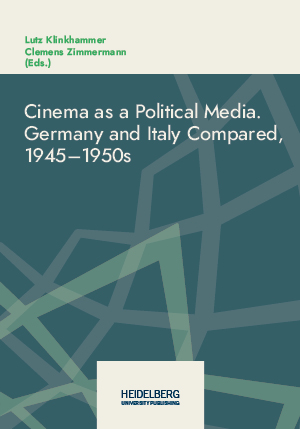Zitationsvorschlag
Identifier (Buch)
Veröffentlicht
Introduction: Cinema as a Political Medium – Germany and Italy Compared from 1945 to the 1950s. The Aims of this Volume
This introductory chapter, firstly, aims at an understanding of the cinematic landscapes of both involved countries and discusses key features of the after-war period. In both countries the cinema was highly relevant in the popular culture of the time. In Italy, explicit political films attracted huge audiences, in a lesser degree in the four zones of the besieged Germany under allied control. But genre-productions like the Heimatfilm were not as un-political as they appeared. Like in Italy, competition by American productions was very strong, and in the American Zone these productions enjoyed political support. The German film industry was weak and fractured, whereas the Italian production recovered in astonishing speed. In both countries Church and bourgeois milieus met the growth of the sphere of the popular, not at last American film, with reservations and resistance. Although in Italy film censorship was abandoned after 1945, productions were increasingly under the pressure of relevant authorities which made use of financing tools, and also the directors were under pressure of moral control. In Germany, the film production was practically completely controlled by the respective Allied Powers. Neither German film in Italy nor Italian film in Germany played, until the beginning 1950s, any role in the cinema landscapes nor film markets of both countries. Secondly, the contribution discusses issues of German film-genres as the “rubble-film”. It is argued that the negative image of post-war German cinema has now begun to change fundamentally. In Italy, post-war film and neorealism cannot be equated. Apart from the canonized productions, historicising dramas, also musical films and Vaudeville films as well as purely classical domestic dramas were successful. Regarding the explicitly political productions, the myth of a collective Italian resistance figured prominently, indeed this was decisive to the popularity of certain neorealist productions. Silences in Italian cinema were to some degree the result of a growing reluctance to engage in any deeper reflection, as the Christian Democracy party became the dominant force (in cultural policy) and investigation into the involvement of Catholic milieus in the Fascist regime was certainly undesirable. Ultimately, censorship “cooperated” with a shift in public taste towards a cinema of entertainment (which brought an embattled film industry much-needed capital in the face of US imports). Thirdly, the article elucidates the main interests in this volume: the political construction of the post-war film and its potential functions in the politics of remembrance, the treatment of the political burdens of the Nazi / Fascist regimes, the treatment of anti-Semitism, the awareness of the Holocaust and the role of anti-Fascist films in a transnational perspective. Furthermore, aesthetic issues of post-war films are explored, as well as questions of ‘quality’.







